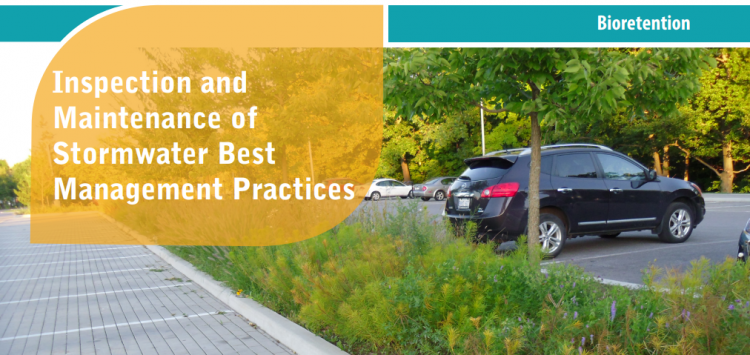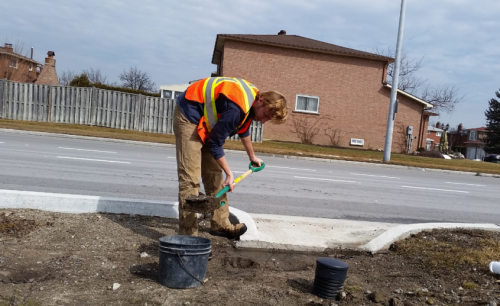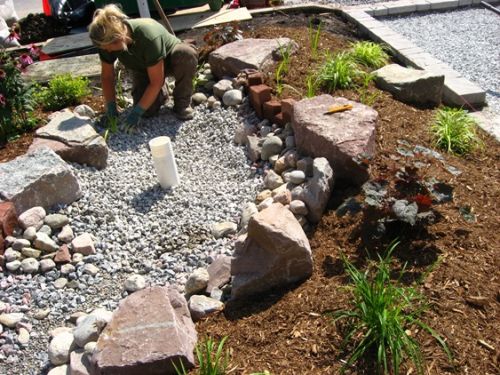Inspection and Maintenance: Bioretention & Bioswales

Overview[edit]
Bioretention treats stormwater by slowing it down, filtering it through soil and plant roots, soaking it into the ground and evaporating it back to the atmosphere. Runoff water is delivered to the practice through inlets such as curb cuts, spillways or other concrete structures, sheet flow from pavement edges, or pipes connected to catchbasins or roof downspouts. The planting bed and side slopes are typically covered with a mixture of plants, mulch and stone. Water in excess of its storage capacity overflows to another BMP or the municipal storm sewer. Filtered water is either infiltrated into the underlying soil to replenish groundwater, or collected by a sub-drain (i.e., underground perforated pipe) and discharged to the storm sewer system or another BMP. Depending on the permeability of the underlying soil or other constraints, it may be designed with no sub-drain for full infiltration, with a sub-drain for partial infiltration, or with an impermeable liner and sub-drain for a no infiltration practice. The sub-drain pipe may feature a flow restrictor (e.g., orifice cap or valve) for gradually releasing detained water and optimizing the amount drained by infiltration. Key components of bioretention practices for inspection and maintenance described further below.
Associated Terminology[edit]
- Bioretention cell: A flat-bottomed, depressed planting bed containing filter media soil, a gravel water storage layer and optional sub-drain pipe(s); Also known as a rain garden.
- Stormwater planters: A bioretention cell contained within an engineered (e.g., concrete) structure.
- Biofilter: Bioretention cell or swale with an impermeable liner or containment structure and sub-drain.
- Dry swale or Bioretention swale: A gently sloping, linear oriented bioretention practice designed to be capable of conveying water across an elevation gradient. Also known as a bioswale or dry swale.
How to Preserve Basic BMP Function[edit]
- Maintain grading of the filter bed (or grass filter strip if present) at curb cut inlets so at least 5 cm of the back of the curb is visible through regular sediment removal and regrading.
- To avoid over-compaction of the filter media soil, any maintenance tasks involving vehicle or foot traffic on the filter bed should not be performed during wet weather.
- For bioretention with sod (i.e., turf grass) as vegetation cover, maintain with a push mower or the lightest mulching ride mower available and core aerate and dethatch annually in the spring to help maintain permeability.
- Pruning of mature trees should be performed under the guidance of a Certified Arborist.
- Woody vegetation should not be planted or allowed to become established where snow will be piled/stored during Winter.
- Removal of sediment from the filter bed surface should be done with rake and shovel, or vacuum equipment to minimize plant disturbance. If a small excavator is to be used, keep it off the BMP footprint to avoid damage to side slopes/embankments and over-compaction of the filter media.
Construction Inspection Tasks[edit]
Construction inspections take place during several points in the construction sequence, specific to the type of LID BMP, but at a minimum should be done weekly and include the following:
- During site preparation, prior to BMP excavation and grading to ensure the CDA is stabilized or that adequate ESCs or flow diversion devices are in place and confirm that construction materials meet design specifications
- At completion of excavation and grading, prior to installation of pipes/sewers and backfilling to ensure depths, slopes and elevations are acceptable
- At completion of installation of pipes/sewers, prior to backfilling to ensure slopes and elevations are acceptable
- After final grading, prior to planting to ensure depths, slopes and elevations are acceptable;
- Prior to hand-off points in the construction sequence when the contractor responsible for the work changes (i.e., hand-offs between the storm sewer servicing, paving, building and landscaping contractors)
- After every large storm event (e.g., 15 mm rainfall depth or greater) to ensure Erosion Sediment Controls (ESCs) and pretreatment or flow diversion devices are functioning and adequately maintained. View the table below, which describes critical points during the construction sequence when inspections should be performed prior to proceeding further. You can also download and print the table here
Construction Sequence Step & Timing |
Inspection Item |
Observations* |
|---|---|---|
| Site Preparation - after site clearing and grading, prior to BMP excavation and grading | Natural heritage system and tree protection areas remain fenced off | |
| ESCs protecting BMP layout area are installed properly | ||
| CDA is stabilized or runoff is diverted around BMP layout area | ||
| BMP layout area has been cleared and is staked/delineated | ||
| Benchmark elevation(s) are established nearby | ||
| Construction materials have been confirmed to meet design specifications | ||
| BMP Excavation and Grading - prior to installation of pipes/sewers and backfilling | Excavation location, footprint, depth and slopes are acceptable | |
| Excavated soil is stockpiled outside the CDA | ||
| Embankments/berms (elevations, slopes, compaction) are acceptable | ||
| Excavation bottom and sides roughened to reduce smearing and compaction | ||
| BMP Installation – after installation of pipes/sewers, prior to backfilling | Structural components (e.g., foundation, walls) installed according to plans, if applicable | |
| Impermeable liner installed correctly, if applicable | ||
| Installations of sub-drain pipes (e.g., locations, elevations, slopes), standpipes/monitoring wells are acceptable | ||
| Sub-drain trench dams installed correctly (location, elevation) | ||
| Landscaping – after final grading, prior to planting | Filter bed depth and surface elevations at inlets are acceptable | |
| Maximum surface ponding depth is acceptable | ||
| Filter bed is free of ruts, local depressions and not overly compacted | ||
| Planting material meets approved planting plan specifications (plant types and quantities) | ||
| Note: for Observation Column: S = Satisfactory; U = Unsatisfactory; NA = Not Applicable* | ||
Routine Maintenance - Key Components and I&M Tasks[edit]
Regular inspections (twice annually, at a minimum) done as part of routine maintenance tasks over the operating phase of the BMP life cycle to determine if maintenance task frequencies are adequate and determine when rehabilitation or further investigations into BMP function are warranted.
Table below describes routine maintenance tasks for bioretention practices, organized by BMP component, along with recommended minimum frequencies. It also suggests higher frequencies for certain tasks that may be warranted for BMPs located in highly visible locations or those receiving flow from high traffic areas (vehicle or pedestrian). Tasks involving removal of trash, debris and sediment and weeding/trimming of vegetation for BMPs in such contexts may need to be done more frequently (i.e., higher standards may be warranted).
Individuals conducting vegetation maintenance and in particular, weeding (i.e., removal of undesirable vegetation), should be familiar with the species of Plants: List specified in the planting plan and experienced in plant identification and methods of removing/controlling noxious weeds. Key resources on these topics are provided below at the links provided:
- Agriculture and Agri-food Canada’s Weed Info database
- Ontario Ministry of Agriculture, Food and Rural Affairs’ Ontario Weed Gallery
- Ontario Ministry of Agriculture, Food and Rural Affairs’ Noxious Weeds In Ontario list
- Ontario Invasive Plant Council’s Quick Reference Guide to Invasive Plant Species
- Oregon State University Stormwater Solutions, 2013, Field Guide: Maintaining Rain Gardens, Swales and Stormwater Planters, Corvallis, OR.
- Plants of Southern Ontario (book), 2014, by Richard Dickinson and France Royer, Lone Pine Publishing, 528 pgs.
- Weeds of North America (book), 2014, by Richard Dickinson and France Royer, University of Chicago Press, 656 pgs.
| Component | Description | Inspection & Maintenance Tasks |
|---|---|---|
| Contributing Drainage Area (CDA) |
Area(s) from which runoff directed to the BMP originates; includes both impervious and pervious areas. |
|
| Pretreatment |
Devices or features that retain trash, debris and sediment; help to extend the operating life cycle; examples are eavestrough screens, catch basin inserts and sumps, oil and grit separators, geotextile-lined inlets, gravel trenches, grass filter strips and forebays. |
|
| Inlets |
Structures that deliver water to the BMP (e.g., Curb cuts, spillways, pavement edges, catch basins, pipes). |
|
| Perimeter |
Side slopes or structures that define the BMP footprint; may be covered by a mixture of vegetation, mulch and stone with slopes up to 2:1 (H:V), or concrete or masonry structures with vertical walls. |
|
| Filter Bed |
Flat or gently sloping area composed of a 0.5 to 1 m deep layer of filter media soil covered by a mixture of vegetation, mulch and stone where surface ponding and filtration of runoff occurs. |
|
| Vegetation |
A mixture of deep rooting perennial plants, tolerant to both wet and dry conditions and salt (if receiving pavement runoff); can include grasses, flowers, shrubs and trees; roots uptake water and return it to the atmosphere; provide habitat for organisms that break down trapped pollutants and help maintain soil structure and permeability. |
|
| Overflow Outlet |
Structures that convey overflows to another BMP or municipal storm sewer. |
|
| Sub-drain |
Optional component; perforated pipe(s) surrounded by gravel and may be wrapped in geotextile filter fabric; installed below the filter media soil layer to collect and convey treated water to an adjacent drainage system; may also include a flow restrictor. |
|
| Monitoring well |
Perforated standpipe that extends from the bottom of the BMP to above the invert of the overflow outlet. Allows measurement of subsurface water level to track drainage performance over time. |
|
Rehabilitation & Repair[edit]
Table below provides guidance on rehabilitation and repair work specific to bioretention and dry swales organized according to BMP component.

| Component | Problem | Rehabilitation Tasks |
|---|---|---|
| Inlets |
Inlet is producing concentrated flow and causing filter bed erosion. |
|
| Filter Bed | Local or average sediment accumulation ≥ 5 cm in depth. |
|
| Surface ponding remains for >48 hours or surface infiltration rate is <25 mm/h. |
| |
| Damage to filter bed or slide slope is present (e.g., erosion rills, animal burrows, sink holes, ruts) |
| |
| Vegetation |
Vegetation is not thriving and filter media is low in organic matter (<3%) or extractable phosphorus (<10 mg/kg) |
|
| Sub-drain |
Sub-drain perforated pipe is obstructed by sediment or roots. |
|
Inspection Field Data Sheet[edit]
Feel free to download (downward facing arrow on the top righthand side) and print (Pinter emoticon on top right hand side) the following Bioretention and Dry swale Inspection Field Data Form developed by TRCA, STEP and its partners for the Low Impact Development Stormwater Management Practice Inspection and Maintenance Guide[4].
The 8 page document prompts users to fill out details previously mentioned above on this page in other sections about various zones associated with Bioretention and Dry swale features (i.e. inlets, perimeter of the feature, filter bed, outlets, etc.) and describe why each area is a pass or fail, and if remediate action is required and under what timeframe it would be completed by. Furthermore, the forms prompt the reviewer to determine what type of inspection is being conducted for the feature in question: Construction (C), Routine Operation (RO), Maintenance Verification (MV), or Performance Verification (PV).
References[edit]
- ↑ TRCA. 2016. Fact Sheet - Inspection and Maintenance of Stormwater Best Management Practices: Bioretention. https://sustainabletechnologies.ca/app/uploads/2018/02/Bioretention-and-Dry-Swales-Fact-Sheet.pdf
- ↑ TRCA. 2019. Low Impact Development Stormwater Inspection and Maintenance Guide. https://sustainabletechnologies.ca/home/urban-runoff-green-infrastructure/low-impact-development/low-impact-development-stormwater-practice-inspection-and-maintenance-guide/
- ↑ TRCA. 2018. Inspection and Maintenance of Stormwater Best Management Practices - Bioretention. Fact Sheet. https://sustainabletechnologies.ca/app/uploads/2018/02/Bioretention-and-Dry-Swales-Fact-Sheet.pdf
- ↑ STEP. 2016. Low Impact Development Stormwater Management Practice Inspection and Maintenance Guide. https://sustainabletechnologies.ca/app/uploads/2016/08/LID-IM-Guide-2016-1.pdf
